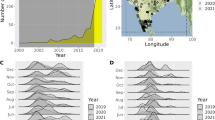Abstract
We tested for the existence of latitudinal gradients in the body sizes of butterflies in North America, Europe, Australia and the Afrotropics. We initially compared body sizes (measured as male forewing length) of all butterflies found in 5° latitudinal bands in each region, and then evaluated the relationship between body size and latitude statistically using the latitudinal midpoint of each species' distribution. Trends were examined for species in all butterfly families together and for each family separately. We found that gradients in body sizes were inconsistent in different geographical regions and butterfly families; in some cases species were larger towards the tropics, in some they were smaller, and in other cases there were no relationships. Most of the gradients, when they existed, reflected between-family effects arising from changes in the relative numbers of species in each family across regions. We conclude that general ecological explanations for geographical trends in butterfly body sizes are inappropriate, and gradients largely reflect historical patterns of speciation within and between taxa in each biogeographical realm. Thus, the robustness of body size gradients found in other insect groups should be confirmed in future studies by including more than one geographical region whenever possible.
Similar content being viewed by others
References
Barlow ND (1994) Size distributions of butterfly species and the effect of latitude on species sizes. Oikos 71: 326–332
Bergmann C (1847) Über die Verhältnisse der Wärmeökonomie der Tiere zu ihrer Grösse. Göttinger Stud 1: 595–708
Common IFB, Waterhouse DF (1972) Butterflies of Australia. Angus and Robertson, Sydney
Cushman JH, Lawton JH, Manly BFJ (1993) Latitudinal patterns in European ant assemblages: variation in species richness and body size. Oecologia 95: 30–37
D'Abrera B (1980) Butterflies of the Afrotropical Region, Lansdowne, Melbourne
Higgins LG, Riley ND (1970) A field guide to the butterflies of Britain and Europe. Collins, London
Lawton JH (1991) Species richness, population abundances, and body sizes in insect communities: tropical versus temperate comparisons. In: Price PW, Lewinsohn TM, Fernandes GW, Benson WW (eds) Plant-animal interactions: evolutionary ecology in tropical and temperate regions. Wiley, New York, pp 71–89
Nylin S, Svärd L (1991) Latitudinal patterns in the size of European butterflies. Holaret Ecol 14: 192–202
Petersen B (1947) Die geographische Variation einiger fennoskandischer Lepidopteren. Zool Bidr Uppsala 26
Scoble MJ (1992) The Lepidoptera. Form, function and diversity. Natural History Museum Publications, Oxford University Press, Oxford
Scott J (1986) The butterflies of North America. A natural history and field guide. Stanford University Press, Stanford
Author information
Authors and Affiliations
Rights and permissions
About this article
Cite this article
Hawkins, B.A., Lawton, J.H. Latitudinal gradients in butterfly body sizes: is there a general pattern?. Oecologia 102, 31–36 (1995). https://doi.org/10.1007/BF00333307
Received:
Accepted:
Issue Date:
DOI: https://doi.org/10.1007/BF00333307




